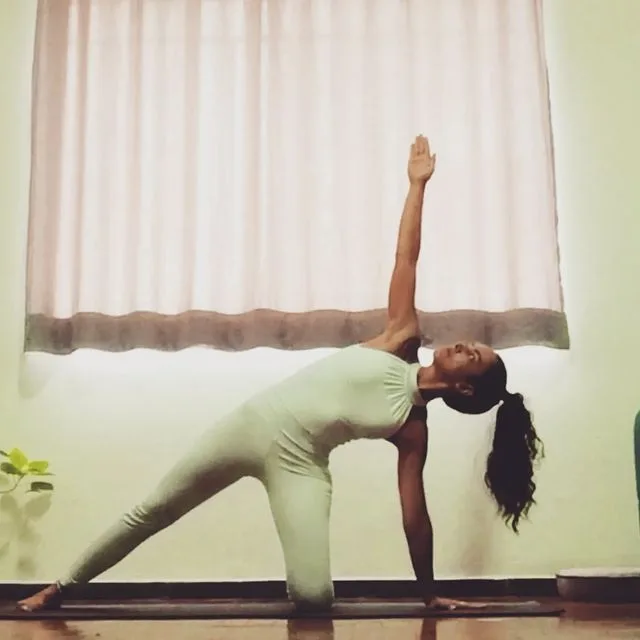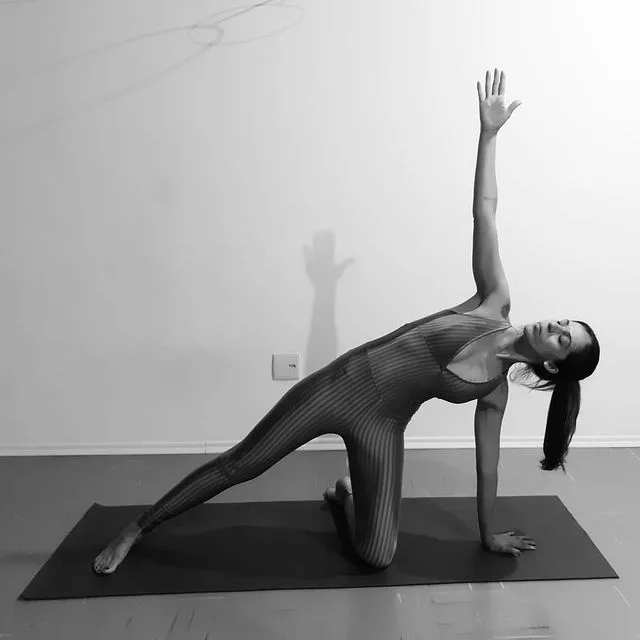Ardha Mandalasana, also known as Half Circle Pose, is a powerful yoga pose that promotes strength, balance, stability, and flexibility.
Expert believes that regular practicing of this yoga pose can strengthens the legs, hips, and core while stretching the spine, hips, and legs.
The pose can help to release any tension that may have built up in the hips, legs, and lower back during this pose and can help to restore balance and stability to the body.
It’s a great pose to include in your yoga practice and can be incorporated into a variety of different styles of yoga, including Hatha, Vinyasa, and Ashtanga.
Information
| Known as: | Ardha Mandalasana, Half Circle Pose, Half-Moon Pose, Ardha Chandra Chapasana, Ardha Chandrasana, Dvadasa Chandra Chapasana, Dvijasana, Dvi Pada Chapasana, Dvi Pada Mandukasana |
| Sanskrit name: | अर्ध चंद्राछपासन |
| IAST: | Ardha Chandra Chapāsana |
| Pronunciation: | ard-hah chun-drah chah-pah-sah-nah |
| Level: | Intermediate level |
| Type: | Balancing |
| Focus: | Balance and stability, core strength, legs, hips, glutes, spine |
| Time: | 20–60 seconds |
| Drishti: | Upwards towards the raised hand; Forward; Eye close |
| Chakra: | Solar Plexus Chakra (Manipura), Sacral Chakra (Svadhishthana) |
| Indications: | Legs, hips, core, balance and stability, lower back pain, digestion, energy |
| Counter poses: | Uttanasana (Standing Forward Bend), Adho Mukha Svanasana (Downward-Facing Dog), Janu Sirsasana (Head-to-Knee Forward Bend), Paschimottanasana (Seated Forward Bend), Marjaryasana (Cat-Cow Stretch) |
| Preparatory poses: | Tadasana (Mountain Pose), Utkatasana (Chair Pose), Vrksasana (Tree Pose), Utthita Trikonasana (Extended Triangle Pose), Virabhadrasana I (Warrior I Pose) |
| Follow-up poses: | Parighasana (Gate Pose), Parsvakonasana (Extended Side Angle Pose), Parvatasana (Mountain Pose), Virabhadrasana III (Warrior III Pose), Utthita Parsvakonasana (Extended Side Angle Pose), Wheel Pose (Urdhva Dhanurasana) |
| Contraindications: | Recent or chronic knee, ankle, or hip injury, High blood pressure, Migraine, Neck injury, Vertigo or balance disorders1, Pregnancy (after the first trimester), Menstruation |
Meaning
The Ardha Mandalasana is derived from the Sanskrit name, which is made up of three words — Ardha + Mandala + Asana:
- “Ardha” = “half”
- “Mandala” = “circle” or “center” or “universe”
- “Asana” = “pose” or “posture”
The pose is named as such because the pose creates the appearance of a half-circle or center with the outstretched arm and the extended leg.
In yoga, the term “Mandalasana” refers to any pose that involves creating a circular shape with the body. This can refer to poses that involve twisting, bending, or extending the body in a circular manner.
The overall meaning of Ardha Mandalasana is a pose that involves creating a half-circle or center shape with the body, while also promoting balance, stability, and flexibility.
Benefits of Ardha Mandalasana (Half Circle Pose)
Ardha Mandalasana offers a number of physical and mental benefits, including:
- Physical benefits:
- Improved balance and stability
- Strengthening of the legs, hips, and core muscles
- Stretching of the hips, legs, and lower back
- Relief from lower back pain
- Improved digestion
- Improved circulation
- Increased energy levels
- Mental benefits:
Ardha Mandalasana (Half Circle Pose) Practice Guide

Ardha Mandalasana is a dynamic and balancing yoga pose. It can become a valuable addition to your yoga routine, you can help to maintain overall health and wellness.
It’s important to practice this pose with proper form and alignment to maximize the benefits and minimize the risk of injury. Make sure to keep your knee aligned over your ankle, and avoid bending your knee too far forward. Keep your core engaged and maintain a steady, controlled breath throughout the pose. If you feel any discomfort or strain, modify the pose or stop and rest as needed.
Step-by-step instructions
Here are step-by-step instructions for practicing Ardha Mandalasana:
- Begin in Tadasana (Mountain Pose). Stand with your feet hip-width apart and your hands at your sides.
- Step your left foot back about 3-4 feet, keeping the foot facing forward. Your feet should be hip-width apart, with the back foot parallel to the front foot.
- Bend your right knee, making sure your knee is directly over your ankle. Keep your core engaged and your back straight.
- Place your right hand on the ground near your right foot, with fingers pointing forward. Make sure your hand is positioned directly under your shoulder.
- Keep your left arm extended forward and reach up towards the sky. Keep your left arm straight and aligned with your shoulder.
- Gaze towards your left hand. Keep your neck relaxed and your gaze soft.
- Hold the pose for 5-10 breaths or 20-60 seconds. Focus on your breath and keep your body steady and balanced.
- To release the pose, straighten your right leg and return to Tadasana. Repeat the pose on the other side.
Tips
- Keep your core engaged: Engage your core muscles by drawing your navel towards your spine. This will help to support your lower back and improve your balance.
- Align your knee over your ankle: Make sure your right knee is aligned over your right ankle, not too far forward or back. This will help to protect your knee joint and reduce the risk of injury.
- Reach up with your left arm: Keep your left arm straight and reach up towards the sky. This will engage your shoulder blades and open up your chest.
- Keep your gaze soft: Keep your gaze soft and relaxed, focusing on your left hand. This will help to reduce any tension in your neck and improve your balance.
- Breathe deeply: Take slow, deep breaths throughout the pose. This will help to oxygenate your body, reduce stress, and improve focus.
Common mistakes
Here are some common mistakes to watch out for when practicing Ardha Mandalasana:
- Bending the knee too far forward: Make sure your knee is aligned over your ankle and not too far forward. This will help to protect your knee joint and reduce the risk of injury.
- Not keeping the core engaged: Engage your core muscles by drawing your navel towards your spine. This will help to support your lower back and improve your balance.
- Collapsing in the torso: Keep your back straight and your torso lifted, avoiding any collapse or slouching. This will help to maintain proper alignment and prevent strain on the lower back.
- Reaching too far forward with the left arm: Keep your left arm straight and aligned with your shoulder, avoiding any reaching too far forward. This will help to maintain proper alignment and reduce the risk of strain in the shoulder.
- Gazing too far forward: Keep your gaze soft and relaxed, avoiding any straining or tension in the neck. This will help to improve your balance and reduce any stress in the neck.
By avoiding these common mistakes, you can practice Ardha Mandalasana with proper form and alignment, maximizing the benefits and minimizing the risk of injury.
Variations of Ardha Mandalasana (Half Circle Pose)
The variations can help you to customize your practice, making Ardha Mandalasana more accessible or challenging depending on your needs and goals.
Here are some variations of Ardha Mandalasana:
Modified Ardha Mandalasana
If you are new to this pose or have limited flexibility, you can modify it by placing your hand on a block or chair instead of reaching for your foot. This will reduce the stress on your lower back and knee, making it more accessible for some individuals.
Dynamic Ardha Mandalasana
To increase the challenge of this pose, you can add a dynamic element by moving your torso forward and back as you inhale and exhale. This will help to improve your balance and coordination, as well as increase the stretch in your hamstring.
Extended Ardha Mandalasana
If you have more flexibility and want to deepen the stretch in your hamstring, you can extend your left leg out behind you and reach for your toes. This will create a greater stretch in your left hamstring, as well as engage your glutes and back muscles.
Bound Ardha Mandalasana
To increase the challenge of this pose and target the hips, you can bind your left foot with your left hand, holding onto your ankle or foot. This will help to create a deeper stretch in your hip flexors and increase the activation of your core muscles.
Precautions and contraindications
By taking these precautions and contraindications into consideration, you can practice Ardha Mandalasana safely and effectively, reducing the risk of injury and maximizing the benefits for your body and mind.
Here are some precautions and contraindications to consider when practicing Ardha Mandalasana:
- Lower back injuries: If you have a recent or chronic injury to your lower back, it’s important to modify or avoid this pose. Ardha Mandalasana places a lot of stress on the lower back, which can exacerbate existing injuries or cause new ones.
- Knee injuries: If you have a recent or chronic injury to your knee, it’s important to modify or avoid this pose. Make sure your knee is aligned over your ankle and not too far forward, which can put excess stress on the knee joint.
- Shoulder injuries: If you have a recent or chronic injury to your shoulder, it’s important to modify or avoid this pose. Reaching up with your left arm can put excess stress on the shoulder joint, which can exacerbate existing injuries or cause new ones.
- Pregnancy: If you are pregnant, it’s important to modify or avoid this pose. Ardha Mandalasana places a lot of stress on the lower back, which can be uncomfortable or unsafe for some women during pregnancy.
- High or low blood pressure: If you have low or high blood pressure, it’s important to modify or avoid this pose. Ardha Mandalasana can increase blood flow to the head, which can worsen symptoms for some individuals with blood pressure conditions.















